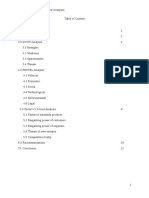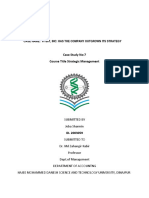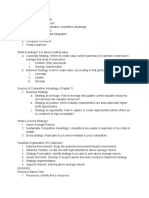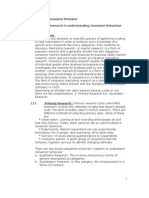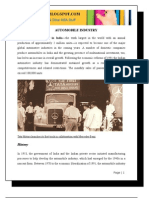Doc
Doc
Uploaded by
simarjeet singhCopyright:
Available Formats
Doc
Doc
Uploaded by
simarjeet singhOriginal Description:
Original Title
Copyright
Available Formats
Share this document
Did you find this document useful?
Is this content inappropriate?
Copyright:
Available Formats
Doc
Doc
Uploaded by
simarjeet singhCopyright:
Available Formats
FITBIT CASE ANALYSIS
NATIONAL ECONOMICS UNIVERSITY
ADVANCED EDUCATIONAL PROGRAM
----------
TEAM CASE WRITING
Subject: Business Strategy and Policy
Topic:
Case 7: Fitbit, Inc.: Has the Company
Outgrown Its Strategy?
Team number: 05
Class: Advanced Accounting 57
Teacher: Dr. Deane Pham
GROUP 5 – Advanced Accounting 57 Page 0
FITBIT CASE ANALYSIS
Hanoi - 2017
GROUP 5 – Advanced Accounting 57 Page 1
FITBIT CASE ANALYSIS
TEAM MEMBERS
Name Order Student ID
Pham Hoang Dung (Leader) 12 11150962
Hoang Tuan Anh 04 11150116
Dao Minh Anh
Nguyen Minh Chau
Bui Thi Thuy Tien
Bui Phan Duc Loc
GROUP 5 – Advanced Accounting 57 Page 2
FITBIT CASE ANALYSIS
Table of Contents
1. EXECUTIVE SUMMARY.............................................................................................................3
1.1. Introduction:...............................................................................................................................3
1.2. Problems:....................................................................................................................................3
1.3. Alternatives:..............................................................................................................................4
1.4. Recommendations......................................................................................................................4
2. ANALYSIS.......................................................................................................................................5
2.1. Company’s Background/ Introduction.......................................................................................5
2.1.1. Company’s Background.......................................................................................................5
2.1.2. Introduction.........................................................................................................................5
2.2. External Industry Analysis: Porter’s Five Force........................................................................6
2.3. Competitive Strategy:.................................................................................................................8
2.4. SWOT Analysis..........................................................................................................................9
2.5. Financial Performance Analysis:................................................................................................9
2.6. Evaluating the Strategy............................................................................................................12
3. RECOMMENDATIONS.................................................................................................................13
Table of Figures
Figure 1: Fitbit's Revenue (2010-2015)..............................................................................................10
Figure 2: Fitbit Shareholders' Equity..................................................................................................11
Figure 3: Fitbit's Liquidity and Profitability Ratios............................................................................11
GROUP 5 – Advanced Accounting 57 Page 3
FITBIT CASE ANALYSIS
1. EXECUTIVE SUMMARY
1.1. Introduction:
Fitbit, Inc., incorporated on March 26, 2007, is a provider of health and
fitness devices. As the leader in the connected health and fitness category, Fitbit
designs products and experiences that track everyday health and fitness. The
Company's platform combines connected health and fitness devices with software
and services, including an online dashboard and mobile applications, data
analytics, motivational and social tools, personalized insight. They capitalized on
consumer health and wellness trends to appeal to a range of consumers- from
fitness enthusiasts to workout novices and virtual coaching through customized
fitness plans and interactive workouts.
1.2. Problems:
The research on fitness trackers reveals that Fitbit currently participated in a
remarkably competitive industry. A lot of competitors, which are advantages of
technological development and introduce new products like smartwatches, make
an effort to gain market share. Therefore the leverage of bargain buyer and threat
of substitutes products is stronger than ever when they have a vast choice of fitness
trackers with various features and price range. Moreover, it was exacerbate for
Fitbit situation by the problem with their goods such as antenna, design flaw,
allergic reactions, etc. This is also the reason why in recently years, the financial
performance of this companies was not positive. After the analysis, we figured out
GROUP 5 – Advanced Accounting 57 Page 4
FITBIT CASE ANALYSIS
that their gross margin profit decreased about 9% from 2015 to 2016 and the target
stock price reduced from $33 to just $18.
1.3. Alternatives:
Based on these conclusions we provide some strategic options for Fitbit, Inc.:
- Expand their Presence in International Markets.
- Increased Focus on Health and Wellness Solutions.
- Renovating their Current Products.
1.4. Recommendations
First of all, Fitbit should do some actions to improve their current product.
Perfecting its product’s outlook and the features are required to enhanced the users’
experience. Secondly, research and development are required to collect useful
information for developing a different new kind of devices or extending its current
product line. Finally - and this is the ultimate recommendation for Fitbit – is
cooperating with medical devices and healthcare customer offerings companies. This
option enables Fitbit to differentiate their product, gain more market share, and avoid
facing strong competitors.
GROUP 5 – Advanced Accounting 57 Page 5
FITBIT CASE ANALYSIS
2. ANALYSIS
2.1. Company’s Background/ Introduction
2.1.1. Company’s Background
Founded: May 1, 2007 by James Park and Eric Friedman.
Headquartered: San Francisco, California, United States.
Products: Fitness trackers, wireless-enabled wearable technology devices.
Main function:
Measure floors climbed, sleep duration and quality.
Track heart rate.
Records weight, body fat and body mass index.
Some Activity Tracker Devices developed by Fitbit: Fitbit Tracker, Fitbit
Ultra, Fitbit Aria, Fitbit Flex, etc.
2.1.2. Introduction
Fitbit is known for its products of the same name, which are activity
trackers, wireless-enabled wearable technology devices that measure data such as
the number of steps walked, heart rate, quality of sleep, steps climbed, and other
personal metrics involved in fitness; and it is by far the leader in the wearable
fitness tracker market, with around 70% of the device market share and 85% of the
market by dollar value as of Q1 2015. However, after years of developing, Fitbit is
recently going through tough time related to its strategy. Their products are
concerned with problems such as antenna, design flaw and allergic reaction issues.
GROUP 5 – Advanced Accounting 57 Page 6
FITBIT CASE ANALYSIS
Moreover, Competition in the activity tracking industry is very aggressive. Fitbit
also reported some privacy issues and cost of launching new products caused
negatively affect to their earnings. To handle with these problems, Fitbit’s
managers have to find out solutions and create more effective strategies for the
company development.
2.2. External Industry Analysis: Porter’s Five Force
Threats of entrants –
Moderate
. 24.5% market share
. Strong brand
. First mover advantage
. Huge industry potential
. Moderate capital investment
Power of supplies – Low Rivalry among competitor – Power of buyers – High
. Moderate switching cost High . Moderate switching cost
. Many alternatives . Strong competitors: Apple, . Wide range of products
. Outsourced manufacture Xiaomi, Garmin, etc. . More feature at low price
. Difficult to imitate product . Similar features
. Easy to imitate features
. No sustained competitive
advantage
Threat of substitute – High
. Low brand loyalty
. Many substitutes
. Technology continuously
evolve
GROUP 5 – Advanced Accounting 57 Page 7
FITBIT CASE ANALYSIS
Buyers’ competitive strength – High
It used to be low since this was only a niche market and there are not so many
competitors, however, due to the proliferation of the technology and high health concern,
many companies started working on fitness tracker devices, providing a wide range of
products (in terms of price, design and purpose) that customers can choose from. Fitbit,
who is the leader of the market, has put more effort on making a versatile device and
innovating even more with new features like texting, fashion accessories and in-app
workouts at a low price to keep the customers attracted.
Suppliers’ competitive strength – Low
Suppliers do not have much power over Fitbit since it uses different vendors for each
product and outsourced manufactures in China. In addition, Fitbit owns Intellectual
Property Certificate of all products, hence, it is hard for manufacturers to imitate, Fitbit
employees also embedded the software into the device by themselves. Having many
alternative vendor who are always ready to manufacture their devices, Fitbit have its
power over the suppliers.
New entrants and substitute products?
Potential entrants/threat of entry – Moderate
Despite of the low entrance barriers, Fitbit still keeps its role as the market leader,
accounting for 24.5% market share. Having built a strong brand name before the market
booming, Fitbit has its own advantage over other new competitors. However, as this
market becomes more attractive recently, there is high chance that other famous
companies such as Michael Kors would start digging into it. New competitors have
forces Fitbit to adjust their pricing, innovate new technology in order to stay competitive.
Substitute product – High
Users have a wide range of choices when it comes to tracking devices such as Smart-
Watch, Smart-phone, etc. A big competitor – Apple, released their Smart watch 2 in
September 16th 2016 has put a huge threat on Fitbit with its latest GPS technology. As
Apply and Fitbit both target fitness enthusiasts with middle to high income rate, they
might be head-to-head competitors.
GROUP 5 – Advanced Accounting 57 Page 8
FITBIT CASE ANALYSIS
Rivalry among competing sellers? – High
Competition used to be low back then, however, because of the continuously evolving
technology and the appearance of other strong brands, brands like Apple, Xiaomi would
constantly create new products to catch up with the changes. The market of fitness
tracking device is getting close to the saturation point, where there are little to no
significant difference between each brand’s products and if a company cannot find a way
to innovatively differentiate their product, it would fail the competition.
In conclusion, because of high rivalry, high buyer power, and high threat of
substitutes, the fitness tracker device industry makes it troublesome to provide a
sustainable competitive advantage. Fitbit should focus on either expanding their total
potential market share, or improving customers’ value, providing helpful and unique
features comparing to its competitors.
2.3. Competitive Strategy:
Generally, Fitbit deploys the Broad Differentiation Strategy:
Strategic target: Everyone who is fitness-enthusiasts and health-conscious,
available not only in sports/fitness stores but also in many other retail stores.
Basis of competitive strategy: Offer buyers wearable fitness tracking devices with
convenience easy access to its community online.
Product line: Broad range of connected health and fitness devices with many
variations from functionality to price.
Production emphasis: Advanced, purpose-built hardware and software technology.
GROUP 5 – Advanced Accounting 57 Page 9
FITBIT CASE ANALYSIS
Keys to maintaining the strategy: Product features and performance + Production
R&D + Technology and innovation + Sales and marketing + Customer service.
2.4. SWOT Analysis
STRENGTHS WEAKNESSES
One-product company – which is easier Designing: plain, simple, could be
to manage and develop. unattractive and old-fashioned.
Broad range of connected health and Privacy Issues: User data was
fitness devices: Fitbit has multiple types transferred to third parties without
and variations of their product range, as customers’ acknowledgement.
well as multiple levels of functionality
and price. Ineffective value chain: very large
manufacturing costs for new products.
First mover advantages: Fitbit had Product malfunction: the antenna, the
joined the market since very soon, thus material has several problems affecting
they may occupy the most market share customers’ experience.
in the field.
Fitbit’s website works as a powerful
foundation of health care: It is
developing by users continuously
throughout their experience.
OPPORTUNITIES THREATS
Niche market for specific and unique Competition: Although Fitbit is holding
purposed devices in health care: Base the most market share in health-
on its nature, Fitbit has chances to tracking devices industry, the
cooperate with more medical centers competition is still cutthroat with both
and utilize Fitbit devices. direct (Xiaomi, Garmin, etc.) and
indirect competitors (smartwatches with
Technology advancements: Innovative fitness-tracking features from Apple,
creation in technology, especially in Samsung, etc.)
wearable devices opens up huge market
potential. Technology barriers: How to combine
Fitbit with other health-related
New lifestyle: There is a huge potential technological devices in use still needs
customer share in wearable devices and a lot of progress.
mobile health industry.
GROUP 5 – Advanced Accounting 57 Page 10
FITBIT CASE ANALYSIS
2.5. Financial Performance Analysis:
Fitbit grew significantly during 4 year period from 2011 to 2015. The
company tripled its revenue in comparison to the previous year in each of the last 5
years, reached 149% in 2015 (compared to 2014).Compared to other industry
suppliers, Fitbit's growth is even more standout. In 2015, Garmin's revenue
decreased 2% and it is also recorded as a decline in 2012 and 2013. Jawbone,
though was a private company, was also reported to have problems dealing with its
debts in 2015. This shows that Fitbit had ability to compete for market share at the
expense of others in the industry.
Figure 1: Fitbit's Revenue (2010-2015)
The success in 2015 of Fitbit was made up by several key decisions such
as: partnering with brands like Sketchers and Strava, product upgrades that
included multisport tracking and heart rate capabilities, and enhanced features of
the Fitbit app.
GROUP 5 – Advanced Accounting 57 Page 11
FITBIT CASE ANALYSIS
The stockholder equity in 2015 rises dramatically in comparison with 2014,
as the company need money to funds the development of new products, new
features and the expansion into new geographic territories.
Figure 2: Fitbit Shareholders' Equity
The main factors that dominants Fitbit’s financial performance are the
liquidity and the profitability level, which is presented in the table below:
GROUP 5 – Advanced Accounting 57 Page 12
FITBIT CASE ANALYSIS
Figure 3: Fitbit's Liquidity and Profitability Ratios
Fitbit seems to be in good financial health, since its liquidity ratios are all
showing positive side. However, the company’s profitability in 2015 resemble
dissimilarity. The gross margin in 2015 is 48.5%, which increases 0.5% in
comparison with 2014, however, the profit margin plummeted to 9%, as opposed to
18% in 2014. This situation is resulted from the inefficient operating activity
expense (significantly on R&D and Marketing), which was increased drastically
throughout the year, leading to only a slight increase in net income (from $131,777
in 2014 to $175,677 in 2015), while revenue gains a 150% boots at the same time.
It can be concluded that the generic strategy acquires success in raising the
company revenue and asset. It is also effective in collecting revenue, however, the
aftermath is that the operating expense and profitability was affected significantly,
which is also influencing Fitbit’s position on the stock market (their stock price has
fallen significantly throughout the researched period).
GROUP 5 – Advanced Accounting 57 Page 13
FITBIT CASE ANALYSIS
2.6. Evaluating the Strategy
It seems that Fitbit’s strategic performance is inadequate. Fitbit's financial
statistics are showing glimpse of instability. Furthermore, Fitbit’s preeminence in
the industry are slowly vanquishing because of their products’ shortcoming and
other fierce competitors such as Apple, Xiaomi or Samsung. They are required to
renovate their strategy to improve the analysts’ assessments of Fitbit.
GROUP 5 – Advanced Accounting 57 Page 14
FITBIT CASE ANALYSIS
3. RECOMMENDATIONS
There are some recommendations for Fitbit’s management:
1. Before creating new products, Fitbit should do some actions to improve
their current product. Fitbit offers simple, friendly devices to customers based on
the foundation of easy and fun fitness tracking, which makes them feel free and
meaningful. If Fitbit can perfect its product’s outlook and the poor materials, the
users’ experience would be enhanced.
2. When the segment for Fitbit’s current products is narrowing, Fitbit
should develop a different new kind of devices, or extend its current product line.
Therefore, research and development are required to collect useful information
about the customers’ wants and needs or the health-related data. By approaching
the habit of the customer and giving them personalized advices about training and
nutrition, Fitbit create big value to customers , in detail, it become a partner who
encourages users, helps them to improve their health.
3. Looking for partners to integrate Fitbit products with medical devices
and healthcare customer offerings. For instance, by co-operating with a doctor’s
office, chain of hospital, etc... Fitbit has more chance to approach different
customers and know more about them. It also a way to gain more market share.
GROUP 5 – Advanced Accounting 57 Page 15
FITBIT CASE ANALYSIS
References:
http://www.idc.com/getdoc.jsp?containerId=prUS41284516
http://marketrealist.com/2017/03/fitbits-team-strategy-benefits-acquisitions-partnerships/
https://en.wikipedia.org/wiki/Fitbit
https://www.investing.com/equities/fitbit-inc-ratios
GROUP 5 – Advanced Accounting 57 Page 16
You might also like
- Dimitris Bertsimas, Robert Michael Freund - Data, Models, and Decisions - The Fundamentals of Management Science (2000, South-Western College Pub.)Document10 pagesDimitris Bertsimas, Robert Michael Freund - Data, Models, and Decisions - The Fundamentals of Management Science (2000, South-Western College Pub.)Rupesh Chaudhari0% (1)
- Bykea: SAAD BIN HAFEEZ (01-221202-042) AMBREEN AKRAM (01-221202-027)Document56 pagesBykea: SAAD BIN HAFEEZ (01-221202-042) AMBREEN AKRAM (01-221202-027)umbreen100% (3)
- Fitbit Case StudyDocument12 pagesFitbit Case Studysimarjeet singh83% (6)
- Mickey C Smith - Pharmaceutical Marketing - Principles, Environment, and Practice-Pharmaceutical Products Press (2002)Document370 pagesMickey C Smith - Pharmaceutical Marketing - Principles, Environment, and Practice-Pharmaceutical Products Press (2002)Paul Francis UyNo ratings yet
- Micro and Macro Environment, Threats and Other Marketing Environments Can Affect FitbitDocument4 pagesMicro and Macro Environment, Threats and Other Marketing Environments Can Affect FitbitHesham Hitch100% (2)
- Haier Case Analysis - Group 2Document15 pagesHaier Case Analysis - Group 2FIZZA ZAIDI-IBM 21IN616100% (1)
- FLIPKART LT-E10 FinalDocument23 pagesFLIPKART LT-E10 FinalSAURABH RAI Student, Jaipuria Lucknow50% (2)
- Brand Personality: Traits of Top Brands: Studio Work Blog Podcast Shop ContactDocument6 pagesBrand Personality: Traits of Top Brands: Studio Work Blog Podcast Shop ContactShawn BNo ratings yet
- Competitive Strategy 1707499Document12 pagesCompetitive Strategy 1707499Ravi KumawatNo ratings yet
- Fitbit Case Analysis - EditedDocument7 pagesFitbit Case Analysis - EditedAswani Brian100% (1)
- Problem Statement Format 1Document74 pagesProblem Statement Format 1Heart EspineliNo ratings yet
- caie-a2-level-business-9609-theory-663a40cf0a2b72167cb31970-445Document8 pagescaie-a2-level-business-9609-theory-663a40cf0a2b72167cb31970-445vnhf4zsf2fNo ratings yet
- Lecture1 v3Document34 pagesLecture1 v3Chandra ShekarNo ratings yet
- UntitledDocument12 pagesUntitledanju antonyNo ratings yet
- Odette Consulting Pepperfry - Com PresentationDocument26 pagesOdette Consulting Pepperfry - Com PresentationJeelNo ratings yet
- C2 Internal Environment Competitive EnvironmentDocument4 pagesC2 Internal Environment Competitive Environmentmahnamabid12No ratings yet
- Assignment 83804Document9 pagesAssignment 83804junejanamya21No ratings yet
- Business Plan For TNTS Standard FormatDocument23 pagesBusiness Plan For TNTS Standard FormatfirstmanoriginNo ratings yet
- Case Study Od..FinalDocument6 pagesCase Study Od..FinalPlik plikNo ratings yet
- Final ReportDocument22 pagesFinal Reportapi-461693941No ratings yet
- Case Study No:7 Course Title Strategic Management: Case Name: Fitbit, Inc: Has The Company Outgrown Its StrategyDocument12 pagesCase Study No:7 Course Title Strategic Management: Case Name: Fitbit, Inc: Has The Company Outgrown Its StrategyJeba Sharmin SrityNo ratings yet
- Strategies To Enhance More Business For Bata ..: The Appreciative Inquiry ModelDocument11 pagesStrategies To Enhance More Business For Bata ..: The Appreciative Inquiry ModelAnirban DawNo ratings yet
- Strategic ManagementDocument32 pagesStrategic ManagementRuslan A GaniNo ratings yet
- MGT 502. Business Strategy, Social Resposibility and SustainabilityDocument22 pagesMGT 502. Business Strategy, Social Resposibility and SustainabilityBaken D DhungyelNo ratings yet
- RDB, Case Study AnalysisDocument57 pagesRDB, Case Study AnalysisJulio CantanteNo ratings yet
- Industry and Competitors AnalysisDocument39 pagesIndustry and Competitors AnalysissauravNo ratings yet
- Case in PointDocument8 pagesCase in PointAkshay ChandnaNo ratings yet
- MIS Unit 2Document50 pagesMIS Unit 2ArchitNo ratings yet
- Level III Improving Business PracticeDocument18 pagesLevel III Improving Business PracticeHabteNo ratings yet
- Positioning Sustainable Brands in The International Market Through E-CommerceDocument20 pagesPositioning Sustainable Brands in The International Market Through E-CommerceTrường NguyễnNo ratings yet
- PESTLE Analysis Patanjali Ayurved LTDDocument7 pagesPESTLE Analysis Patanjali Ayurved LTDvaidehi50% (2)
- Project Report: School of Business Oct 2012Document28 pagesProject Report: School of Business Oct 2012Prosenjit RoyNo ratings yet
- Business Operation Skills-Kim 104: Presented By: Muhammad Mahbub Alam FCADocument6 pagesBusiness Operation Skills-Kim 104: Presented By: Muhammad Mahbub Alam FCAMd. Rayhanul IslamNo ratings yet
- Session_4_ComptDocument25 pagesSession_4_ComptshaguftaNo ratings yet
- Ge Matrix NotesDocument13 pagesGe Matrix Notes51095BRizwana KhojaNo ratings yet
- Chapter 2Document18 pagesChapter 2Yosef KetemaNo ratings yet
- Applied Economics Reviewer (2nd Periodical)Document24 pagesApplied Economics Reviewer (2nd Periodical)casumbalmckaylacharmianNo ratings yet
- Lecture Notes & Cases-Marketing EnvironmentDocument11 pagesLecture Notes & Cases-Marketing EnvironmenttagashiiNo ratings yet
- Strategic and Marketing Planning L6Document37 pagesStrategic and Marketing Planning L6Cian RamosNo ratings yet
- Strategic ManagementDocument123 pagesStrategic Managementdr.noreen nasseryNo ratings yet
- PD1A Product DevelopmentDocument122 pagesPD1A Product DevelopmentNandepu Sravan KumarNo ratings yet
- SDT Assignment - Epgpx02 - Group 10Document6 pagesSDT Assignment - Epgpx02 - Group 10PARDEEP GARGNo ratings yet
- Strat MannnnnDocument3 pagesStrat MannnnnKerb6 AngalaNo ratings yet
- IBM Strategy and Organization Design ReportDocument20 pagesIBM Strategy and Organization Design ReportAnuj ShresthaNo ratings yet
- Product Management - 15 Sep 09Document151 pagesProduct Management - 15 Sep 09anishpatel4uNo ratings yet
- Lecture 14Document12 pagesLecture 14Udaya sankari sankariNo ratings yet
- Xiaomi's Product Launch in AustraliaDocument16 pagesXiaomi's Product Launch in AustraliaSheraz KhanNo ratings yet
- Competitor AnalysisDocument6 pagesCompetitor Analysiskhengmai0% (1)
- Explains Why Does The Company ExistDocument14 pagesExplains Why Does The Company ExistNoor El-RifaiNo ratings yet
- GROUP 1. Industry Life Cycle ModelDocument25 pagesGROUP 1. Industry Life Cycle ModelErica Gonzales GaspeNo ratings yet
- CMR - Session 1 - Updated - ME BasicsDocument18 pagesCMR - Session 1 - Updated - ME Basics1DA19EI023PAVITHRA.K.NNo ratings yet
- Exam ReviewerDocument6 pagesExam ReviewerInah RoblesNo ratings yet
- Strategic Management II - Portfolio Analysis and Strategic ChoiceDocument32 pagesStrategic Management II - Portfolio Analysis and Strategic ChoiceArup BaksiNo ratings yet
- Interpreneurial Skills Final Exam Dec 22Document17 pagesInterpreneurial Skills Final Exam Dec 22Fungai MajuriraNo ratings yet
- Strategy Analysis and ChoiceDocument41 pagesStrategy Analysis and Choiceghazanfartoor100% (2)
- BS-FinalDocument81 pagesBS-FinalAyubAliNo ratings yet
- External EnvironmentDocument22 pagesExternal Environmentramunex456No ratings yet
- MKT525 Prashant Chauhan Section: Q1E50Document18 pagesMKT525 Prashant Chauhan Section: Q1E50Harsh JayswalNo ratings yet
- Assignment 1 - Julie (Scribd)Document23 pagesAssignment 1 - Julie (Scribd)Julie PhamNo ratings yet
- MDI GDPI Prep - StrategyDocument10 pagesMDI GDPI Prep - StrategyDevavrat SinghNo ratings yet
- Strategy TemplateDocument11 pagesStrategy TemplatemhyloveNo ratings yet
- Strategy Analysis and ChoiceDocument32 pagesStrategy Analysis and ChoiceShoukat AliNo ratings yet
- Lecture Notes Marketing FinanceDocument57 pagesLecture Notes Marketing FinancePoojak1989No ratings yet
- The Intellectual Property Pyramid Assessment:: A Novel Method for Creating a Sustainable Competitive AdvantageFrom EverandThe Intellectual Property Pyramid Assessment:: A Novel Method for Creating a Sustainable Competitive AdvantageNo ratings yet
- Retailing VocabularyDocument19 pagesRetailing VocabularyAnand50% (2)
- Sales and Channel Management-EMU4180838Document10 pagesSales and Channel Management-EMU4180838imursoln15100% (1)
- Art of Pricing, The.1docxDocument10 pagesArt of Pricing, The.1docxlycscNo ratings yet
- CMIE 1213 Pembangunan Perusahaan Mikro Dan Kecil Set 2023/2024Document14 pagesCMIE 1213 Pembangunan Perusahaan Mikro Dan Kecil Set 2023/2024farahinNo ratings yet
- MKT113 - Retail Management - CCEDocument37 pagesMKT113 - Retail Management - CCEJoanna Marie SimonNo ratings yet
- A Study On Consumer's Perception Towards Honda Activa in Lucknow CityDocument37 pagesA Study On Consumer's Perception Towards Honda Activa in Lucknow CityChandan SrivastavaNo ratings yet
- Agrola Switzerland PDFDocument435 pagesAgrola Switzerland PDFDataGroup Retailer AnalysisNo ratings yet
- Thapar University MBA-2010 LMTSOMDocument81 pagesThapar University MBA-2010 LMTSOMAnkur VermaNo ratings yet
- Consumer Behavior Module 2: Role of Research in Understanding Consumer BehaviourDocument34 pagesConsumer Behavior Module 2: Role of Research in Understanding Consumer BehaviourShams TabrezNo ratings yet
- Customer Loyalty Is Overrated and Old Habits Die Hard, But They Do DieDocument11 pagesCustomer Loyalty Is Overrated and Old Habits Die Hard, But They Do DieDr. Anila FaisalNo ratings yet
- Proposal For: Pepper Content Proposal By: AaryanmatascoDocument10 pagesProposal For: Pepper Content Proposal By: AaryanmatascoSudarshan SNo ratings yet
- 03 Identifying and Improving Bad User StoriesDocument3 pages03 Identifying and Improving Bad User StoriesElaine BarrosNo ratings yet
- Elasticity Part1 CopyDocument39 pagesElasticity Part1 Copymohamedrgb123321No ratings yet
- Chapter 14 Exam Questions - 8th EdDocument11 pagesChapter 14 Exam Questions - 8th EdUdhbhav Aryan100% (1)
- Rivers State University Business Schoo1Document4 pagesRivers State University Business Schoo1flamesgraphixsNo ratings yet
- Areas of Innovation ExplanationDocument5 pagesAreas of Innovation ExplanationJerusha AlmonteNo ratings yet
- Mission VisionDocument3 pagesMission VisionJuvy GutierrezNo ratings yet
- Marketer S Squad: - Ayaz Mahmud - MD. Salahuddin Huq - Ishrat Ahmed Era - Sabnoor Hassan Soha - Golam Naser ZilanyDocument14 pagesMarketer S Squad: - Ayaz Mahmud - MD. Salahuddin Huq - Ishrat Ahmed Era - Sabnoor Hassan Soha - Golam Naser ZilanyNiloy SahaNo ratings yet
- Entrepreneurship Business PlanDocument17 pagesEntrepreneurship Business PlansangguniangkabataanmabuhayNo ratings yet
- Chapter 5Document37 pagesChapter 5Ahmed ElbazNo ratings yet
- Ganesh 96Document3 pagesGanesh 96amit.foodshipNo ratings yet
- A Study On DiscountsDocument11 pagesA Study On DiscountsParth kachhawahNo ratings yet
- Stock Pitch - VCDocument11 pagesStock Pitch - VCVincenzo CassoneNo ratings yet
- Craft Better Stories With Shapes From Kurt Vonnegut - Response MarketingDocument9 pagesCraft Better Stories With Shapes From Kurt Vonnegut - Response MarketingdorothyNo ratings yet
- Rural Marketing ProjectDocument21 pagesRural Marketing ProjectSurpreet Singh PaviNo ratings yet
- Project On Automobile IndustryDocument69 pagesProject On Automobile IndustryAshutosh Porwal100% (1)













